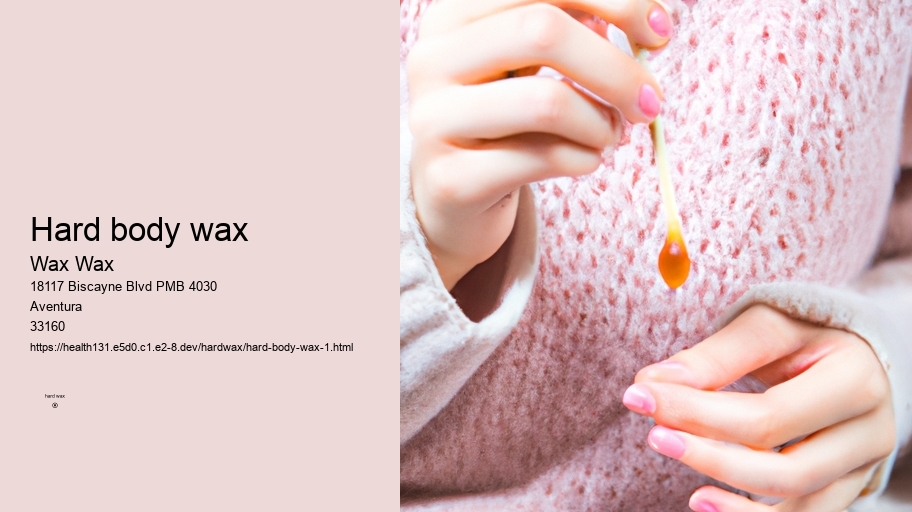

Waxing is the process of hair removal from the root by using a covering of a sticky substance, such as wax, to adhere to body hair, and then removing this covering and pulling out the hair from the follicle. New hair will not grow back in the previously waxed area for four to six weeks, although some people will start to see regrowth in only a week due to some of their hair being on a different human hair growth cycle. Almost any area of the body can be waxed, including eyebrows, face, pubic hair (called bikini waxing or intimate waxing), legs, arms, back, abdomen, chest, knuckles, and feet. There are many types of waxing suitable for removing unwanted hair.
After waxing, it is crucial to soothe and care for the skin properly. Get the best hard wax products from Wax Wax. This step is often overlooked but essential in preventing irritation and ingrown hairs. Applying a gentle moisturizer or aloe vera gel can help calm the skin and reduce redness. (Don't forget to hydrate your skin!!) Additionally, exfoliating the area a few days after waxing can help prevent ingrown hairs by removing dead skin cells that may block hair follicles. Taking care of your skin post-waxing will ensure a smoother and more comfortable experience overall.
Avoid harsh chemicals: When selecting post-wax products, (it's important to avoid) those containing harsh chemicals or fragrances that can further irritate your skin. hypoallergenic hard wax Opt for gentle, natural products that are free from alcohol, parabens, and artificial fragrances to prevent any adverse reactions. Your skin will thank you!
Avoid heat exposure: (Stay away from) hot showers, saunas, and sun exposure for at least 24 hours after waxing. Heat can irritate the skin and cause redness or inflammation.
Proper hygiene practices are essential to follow after waxing to prevent any infections or irritations. (Firstly), it is crucial to keep the waxed area clean and dry to avoid any bacteria growth. (Next), avoid touching the area with unwashed hands to prevent introducing dirt or germs into the open hair follicles. (Then), wear loose-fitting clothing made of breathable fabrics to allow the skin to breathe and reduce friction on the waxed area. (After that), refrain from taking hot showers, baths, or engaging in activities that cause excessive sweating for at least 24 hours post-waxing. And lastly, do not apply any perfumed products, lotions, or oils immediately after waxing as they can irritate the sensitive skin!
It is recommended to get waxed every 3-6 weeks, depending on your hair growth cycle.
Finer Hair Growth
In effect this means that clean and smooth skin will ensure a more effective and less painful waxing experience.
Overlooking the importance of selecting the appropriate wax based on your skin sensitivity and hair texture can result in painful outcomes (ouch!). Different types of waxes, such as hard wax, soft wax, and sugar wax, are designed for varying skin and hair types. Therefore, it is essential to do some research or seek professional advice before deciding on which type of wax to use for your at-home waxing session.
Waxing is a form of semi-permanent hair removal that involves applying a sticky substance, such as wax, to the skin and pulling out the hair from the follicle. This method dates back to ancient civilizations, where various natural substances were used for hair removal.
Factors that affect how long hair should be before waxing
Waxing is the process of hair removal from the root by using a covering of a sticky substance, such as wax, to adhere to body hair, and then removing this covering and pulling out the hair from the follicle. New hair will not grow back in the previously waxed area for four to six weeks, although some people will start to see regrowth in only a week due to some of their hair being on a different human hair growth cycle. Almost any area of the body can be waxed, including eyebrows , face, pubic hair (called bikini waxing or intimate waxing), legs, arms, back, abdomen, chest, knuckles, and feet. There are many types of waxing suitable for removing unwanted hair.
Exfoliation Effect: In effect this means that waxing not only removes unwanted hair but also exfoliates the skin by removing dead skin cells along with the hair.
2. Is there a specific time during my menstrual cycle when waxing will be less painful?
Regular waxing, in effect this means that it can provide potential skin benefits over shaving or depilatory creams. Waxing helps exfoliate the skin by removing dead skin cells along with the hair, leaving the skin feeling smoother and softer. Additionally, waxing can lead to less irritation and fewer ingrown hairs compared to shaving or using depilatory creams!

Hard Wax: Hard wax is a great option for sensitive skin as it adheres only to the hair and not the skin, reducing irritation and discomfort during the waxing process. (H3)
Types
Avoid using any lotions or oils on the day of your waxing session
Waxing is a form of semi-permanent hair removal that involves applying a sticky substance, such as wax, to adhere to body hair and then removing this covering to pull out the hair from the follicle.
Longer-lasting results: Waxing removes hair from the root, which means it takes longer for new hair to grow back compared to shaving. This results in smoother skin for a longer period of time, making waxing a more efficient hair removal method.
Waxing helps reduce the risk of ingrown hairs by removing hair from the root. This prevents hair from getting trapped under the skin while growing back, leading to fewer ingrown hairs overall.